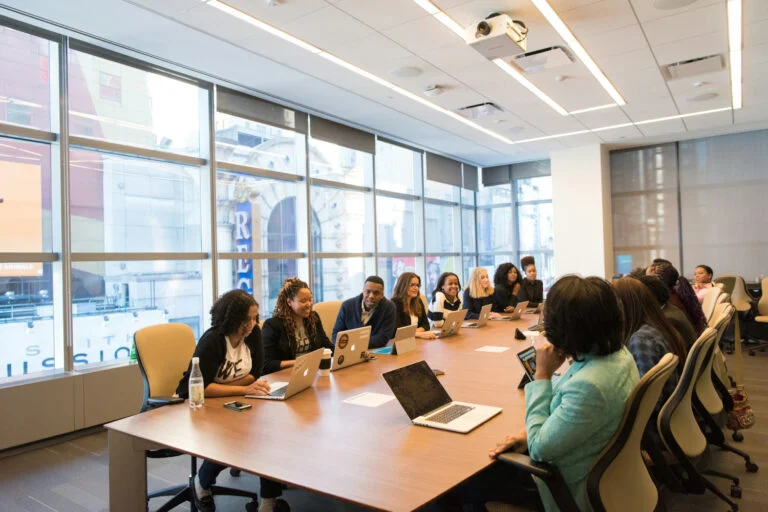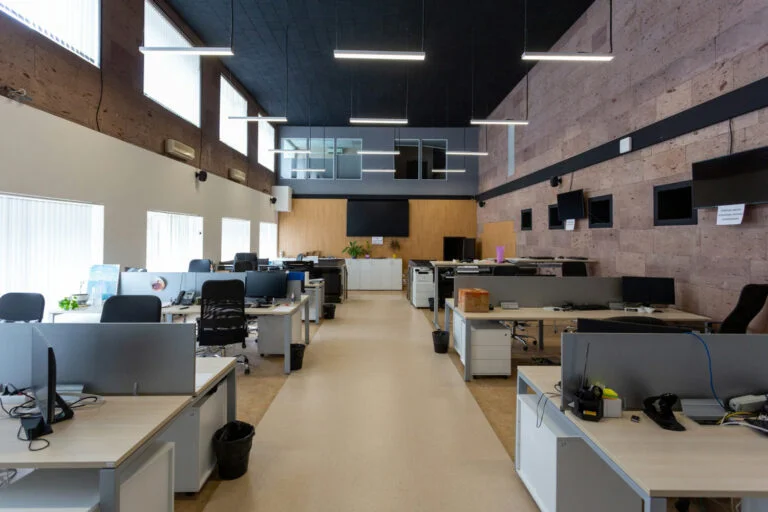The era of traditional offices has passed, but its legacy lives on. Despite consistent forecasts of its decline, the concept of the office persists, adapting and surviving as a vital element in our professional journey.
Across the ages — spanning from ancient scriptoria and the pioneering skyscrapers of Lloyd-Wright to present-day innovative campuses akin to Apple and the revitalized urban zones of contemporary society — we've witnessed offices transform in design and function, echoing the prevailing economic ideologies, technological advancements, and business ventures of each era. This process of evolution is rapidly accelerating.
Within the contents of this article, we will delve into the evolution of office environments and explore the potential transformations that await the workplaces of the future.
The Future Disruption of Work: Unveiling Transformative Changes
The future landscape of work has been profoundly disrupted. The rapid advancement of digital technologies is fundamentally reshaping our tasks and
demanding a reimagining, construction, and operation of our workplaces. Automation and artificial intelligence, pivotal components of the Fourth Industrial Revolution, are poised to render certain job roles obsolete, while concurrently birthing new ones.
Marking an unprecedented occurrence, our future workforce encompasses four distinct generations, necessitating offices that can adeptly accommodate and evolve alongside the diverse needs and talents of its occupants. This adaptive approach seeks to cultivate meaningful engagement and cooperative endeavors.
Simultaneously, urbanization has reached unprecedented heights, drawing an increasing number of individuals to cities in pursuit of employment and various prospects. This phenomenon contributes to a surge in economic, environmental, and societal pressures within select urban pockets, manifesting as challenges like affordable housing scarcity.
Try UnSpot for free
Get a smart solution to manage your hybrid workplace, create work schedules, book desks and meeting rooms, schedule meetings, and get office analytics.
The Advantages of Future Physical Work Environments
Beyond mere social interactions, physical workspaces offer distinct benefits that cannot be replicated in a virtual realm. Let's delve into the reasons why offices retain their critical role for both companies and their employees, and the invaluable contributions these workspaces provide.
The Value of Future Physical Workspaces: An Overview
1. Nurturing Belonging and Community
Physical workspaces serve as the crucible for employees to cultivate relationships with their peers. This symbiotic connection is paramount for fostering trust, enhancing collaboration, and engendering a sense of belonging and community.
The daily interactions with coworkers naturally forge a camaraderie. Whether engaging in casual conversations or sharing a meal, these routine interactions fortify bonds, fostering a profound team cohesion.
Thoughtful workspace design incorporates communal areas where individuals can converge and engage. Shared locales like kitchens, lounges, and meeting rooms foster collaborative endeavors, social intermingling, and valuable networking.
2. Elevating Communication
Face-to-face interactions transcend the capabilities of their virtual counterparts. The physical presence of an individual holds an intangible essence that eludes digital replication.
The nuances of body language, facial expressions, and tone of voice carry profound meanings, often lost in the realm of online communication. Operating within a tangible office setting allows for a more organic and immediate form of communication.
For instance, if a query arises or assistance is needed, one can simply stroll to a coworker's desk and engage in a direct conversation. This form of communication often proves more efficient than composing emails or instant messages and awaiting responses.
3. Enhancing Productivity
An office environment, devoid of domestic distractions, serves as a fertile ground for heightened productivity.
By designating a separate workspace from the domestic surroundings, employees can effortlessly transition into their "work mode," minimizing potential diversions. Distance from household tasks, pets, and other distractions enables a devoted focus on professional obligations.
Moreover, office settings grant access to tools and resources potentially absent in a home office. Specialized software and equipment, including ergonomic furniture to prevent strain and fatigue, contribute to increased efficiency.
A comprehensive analysis of 250 ergonomics case studies conducted by the Washington State Department of Labor and Industries unveiled a 25% surge in productivity through the implementation of ergonomic solutions.
4. Cultivating a Positive Company Culture
Thoughtfully designed physical workspaces provide a fertile ground for collaborative ideation, a cornerstone of creativity and innovation. This, in turn, nurtures a positive company culture, yielding augmented employee satisfaction and retention — a magnet for attracting and preserving top-tier talent.
5. Safeguarding a Tangible Work-Life Balance
A dedicated physical workspace delineates clear boundaries between professional endeavors and personal life. The allure of using a couch or bed as a makeshift workstation diminishes, thereby enabling a more distinct demarcation between work and leisure.
Maintaining a routine is facilitated through commuting to a physical office. In contrast, working from home can be susceptible to procrastination or postponed tasks.
The existence of a designated office space fosters adherence to a routine, yielding gains in productivity, mental well-being, and stress management.
6. Fostering Opportunities for Professional Growth
Physical offices serve as catalysts for immersive learning experiences, a facet irreplaceable in the virtual sphere. While online training has its merits, in-person training sessions offer heightened interactivity and engagement.
Hands-on trainers proffer live demonstrations, address queries in real-time, and orchestrate group discussions. This personalized guidance often proves pivotal in grasping novel concepts and skills.
Additionally, physical office environments grant access to resources that may elude remote settings, such as research materials, libraries, and emerging technologies. Such access empowers employees to acquire proficiencies essential for assuming new responsibilities and propelling their careers forward.
Desired Working Model: The Preference for a Hybrid Approach
Amidst the choices of hybrid, flexible, and decentralized work arrangements, employees are clearly leaning towards a hybrid model. This inclination is supported by compelling statistics:
Recent findings from IWG's research indicate that six out of ten workers express a desire to return to the office once employers permit it.
Conversely, the same report highlights that half of these individuals would consider leaving their jobs if mandated to work five days a week from the office.
Addeco's study reveals that 74% of respondents now seek a blend of office-based and remote work, aiming to allocate 51% of their working time in the office and the remaining 49% working remotely.
Gensler's research aligns with these sentiments, with 70% of participants expressing a preference to work from the office a few days each week.
However, this sentiment isn't limited to employees alone—employers are equally enthusiastic about embracing a reimagined workspace. The hybrid workplace model offers several advantages, including reduced office space costs, heightened employee productivity, and an expanded talent pool.
Of course, the implementation of the hybrid model introduces an added layer of management complexity. Fortunately, numerous hybrid software solutions exist to streamline this process.
The demand for a hybrid working model underscores a significant insight: both employers and employees are open-minded about the how and where of optimal work execution.
For those interested in delving further into the management aspects of the hybrid workplace, our Guide to Building a Sustainable Hybrid Workplace Model offers valuable insights.
Shifting from Traditional to Flexible Offices
The corporate future landscape is already undergoing a transition from conventional to adaptable office spaces. Some enterprises are contemplating the rental of compact regional offices and coworking desk spaces in close proximity to their employees' residences.
This trend towards workspace decentralization is gaining rapid momentum, often referred to as the 'hub and spoke' model. This innovative approach amalgamates a centralized office hub, regional workspaces, and a home-based office—a true embodiment of the hybrid concept.
From the employee vantage point, this decentralized workspace model offers the flexibility to work from home while simultaneously providing access to a suitable work environment in proximity to their domicile.
Furthermore, this setup fosters collaboration with local colleagues, enabling social interaction and meaningful peer engagement.
From a business perspective, this approach can yield cost savings. Instead of investing in a sizable downtown office space, expenses can be distributed across multiple workspaces in more cost-effective locales.
Embracing the Present and Shaping Tomorrow
We stand at the precipice of an extraordinary juncture—the office, a space entrenched in familiarity, is undergoing an extensive and transformative evolution as we usher in the next chapter of its history. In this era, it is imperative for workplace designers, developers, occupants, and users alike to grasp the reverberations of these changes on future workspaces and their own professional trajectories.
Though we are in the early stages of this transition, the offices of tomorrow are already taking form—conceived, designed, erected, and inhabited. The ongoing digital revolution within the realm of workplaces exerts a profound influence across the entire building lifecycle: from inception, outlining, and acquisition, to construction, customization, operation, and maintenance. In this process, collaboration emerges as the linchpin, a conduit that ensures offices are attuned to the contemporary demands of users today, poised to cater to the exigencies of tomorrow, and poised to stand the test of time across future generations.
Adapting to the Future Office Space: A Comprehensive Approach
In light of the growing preference for remote work, businesses must proactively embrace change and adjust to this evolving reality to sustain their competitiveness and achieve ongoing success.
Navigating the Office Space of Tomorrow: Strategies for Success
Embrace Technological Integration
In the modern work landscape, technology reigns supreme. Companies that invest in cutting-edge technologies empower their workforce to perform efficiently and effectively, regardless of their physical location.
From video conferencing tools to collaborative platforms, choosing the right technological solutions can significantly enhance the performance of your hybrid team. Take, for instance, OfficeRnD, an encompassing platform meticulously designed to facilitate the streamlined management of flexible and hybrid workplaces. Equipped with features like desk scheduling, automated billing, and seamless payments, our robust platform simplifies the administration of hybrid office spaces.
To better grasp the capabilities of OfficeRnD's hybrid work management platform, take a moment to explore the video below:
Cater to Diverse Needs
Acknowledging the individuality of each employee is pivotal. Consider the distinct requirements of every team member. While some thrive amidst absolute silence, others draw inspiration from music and ambient sounds.
To accommodate the entire spectrum of preferences, your office space should encompass a diverse array of work settings, ranging from serene private zones to collaborative, open environments. Employ adaptable elements like movable partitions, modular furnishings, and versatile lighting to create spaces that can be easily reconfigured to suit various tasks and work styles.
Tailoring the workspace to each employee's circumstances is equally essential. Recognize that a parent caring for a toddler may seek the flexibility of remote work. Similarly, some team members may be more productive when working outside the confines of the traditional nine-to-five schedule.
Prioritizing flexibility fosters elevated employee satisfaction and productivity, paving the way for a harmonious and triumphant team dynamic.
Nurture Creativity and Community
To harness your team's innovative potential, cultivate a workspace that nurtures creativity.
For instance, the interplay of color and light can wield a significant influence over mood and creativity. Infuse vibrant, bold colors or distinctive lighting fixtures to infuse energy and intrigue into the environment.
Dedicate collaborative zones thoughtfully designed for group endeavors, such as communal tables and brainstorming corners. Consider the office space as an artistic canvas, adorning it with artwork or creative projects from employees to ignite inspiration and foster a sense of community.
Provide Well-Tailored Amenities
Employees equipped with comfortable, well-appointed workspaces are inherently more inclined to maintain focus and productivity. Standing desks, lounge areas, and wholesome snacks all contribute to a work milieu that nurtures efficiency.
The provision of consistent amenities for all staff members, regardless of their work location—be it the office or home—ensures fairness and demonstrates an earnest appreciation for employees' choices regarding their work settings.
A diverse range of amenities can also wield significant appeal in recruitment, particularly for younger professionals who highly value work-life equilibrium and well-being.
Rethink Spatial Requirements
The rise of remote work and adaptable schedules has prompted numerous companies to reconsider their spatial needs. While downsizing to a more compact workspace can yield cost efficiencies, it's imperative to retain adequate physical office space to accommodate the benefits it imparts.
Hot desking emerges as an exceptional alternative due to its inherent flexibility and optimal space utilization. Beyond cost-effectiveness, this adaptable workplace model nurtures collaboration and knowledge exchange among employees who might not otherwise interact.
Embracing a hybrid workplace model empowers companies to leverage the strengths of both physical and remote work environments, ultimately fostering a more engaged and productive workforce.









